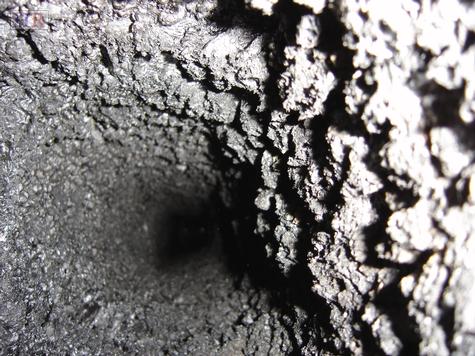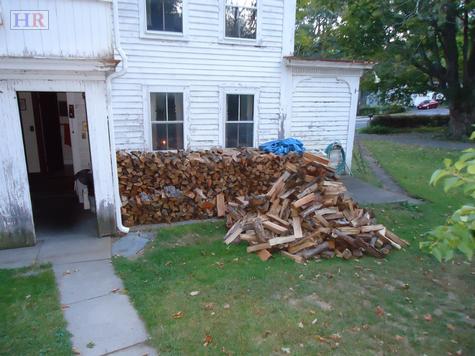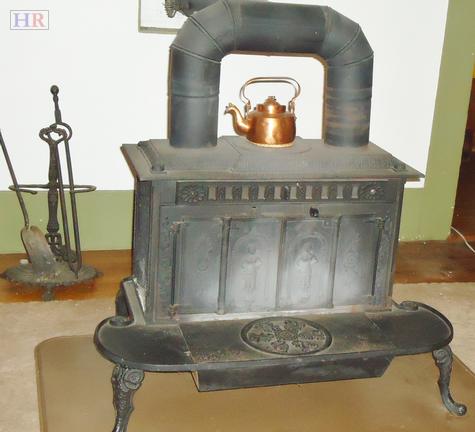Chimneys and Firewood
They are the performance of people cleaning chimneys, and the availability of properly “seasoned” firewood. Not too long ago I hired a “Licensed” chimney sweep to clean the chimney used for my antique kitchen range. It is a square brick chimney with an inside perimeter eight inches each side. I watched this licensed professional put a six inch round brush down the flue once, then come down off the roof. I thought to myself that the procedure I just watched couldn't have done much to remove the creosote lining the chimney. My house was built two hundred years ago as a shoe factory. Each room had a stove, so there is access to the chimneys at all three floors of the house. I took some photos. As this picture shows, that chimney wasn't remotely clean. That means that the chimney was unsafe to use.

If I had not had experience and knowledge of chimneys from my past, I would probably have used my stove with the deluded belief that my chimney was safe. I called the man I had just given $150 and told him I wanted the job done properly. He returned after several calls, pushed a square eight inch brush down the flue, at my request scrubbed the inside with the brush, but he never made it all the way down the chimney with that brush. When he came down he told me that I had a tapered chimney. Remarkable. I want to meet the mason who would build a downward tapered chimney. When I asked him to remove the soot and creosote he had just sent to the bottom of the chimney, he told me that he did not do that. I gave up on that chimney “expert” and had the job done again by a more reliable specialist.
A spark that falls down the chimney can ignite combustible waste left in the bottom of a chimney. It slowly develops into a smoldering molten mass. I know because that happened in my chimney about twenty years ago. That kind of fire can go unnoticed for days, but it will heat the chimney brick enough to eventually ignite any wood surrounding the chimney. I only discovered the fire because I recognized the smell when I was in the yard a day after the fire had established itself. In a very impressive exercise of safe procedures and neatness even in an emergency, the Holliston Fire Department rescued my house.
What I have reported above leaves a problem for many trusting people. Effectively, there is no license required for a chimney sweep in Massachusetts. Some people in the chimney cleaning business have a Mass. Construction Supervisor's license, required by the state for installing solid fuel burning devices. Others advertise themselves as “certified.” This means they belong to a professional organization. The problem is, then, that the chimney cleaning trade is essentially self regulating. I am sure that the majority in the chimney cleaning business are reliable, but ones like the one I experienced create a distinct public safety issue.
More on this matter needs to be done. Legislation to regulate the trade has been filed over several years, by me among others, but there is as yet no real regulation of an industry that has the potential to put a great many people at risk: begin with homeowners and their property, their neighbors, and firefighters.
It does not matter how well a chimney is cleaned if the fuel in the stove the chimney exhausts is wet, or unsafe because of its composition. Most evergreen wood ---pine, fir, or other soft woods such as willow, or mulberry will generate creosote and tars when burned. At best, that kind of wood is only good used as kindling. Dry hardwoods, generally meaning oak, maple, beach and ash, common in New England, burn cleanly.
.

One of the pleasures in my life is the hundred year old wood-burning kitchen range I have used for over fifty years. When I was young I cut and split my wood. As I aged I began to cavort with wood dealers. I bought four foot lengths of hardwood, stacked them, and, at my own pace, I cut, split, piled, and covered the wood. Much was stored inside, where weather was not a consideration. I did not neatly stack it because I was not concerned with measuring the supply. I did know that I needed about two cords of wood each season. In those days my supply was always from a year to eighteen months old before I burned it. It was well seasoned wood, and burned cleanly. To tell the truth, I did not have the chimney cleaned every year because it was unnecessary.
Time marches on, and for the last ten or twelve years, I have bought all my wood from dealers seasoned, cut, split and supposedly ready to burn. Recently I ordered two cords of wood, and something told me to stack the wood. When I finished piling it neatly, and measured the yield, I discovered that I was three quarters of a cord short. At $200 a cord that was a little too much for me. I called the dealer, with whom I had done business for several years, and with neither question nor argument he delivered the missing amount.

As I stacked the additional wood I recognized that the wood was just plain green. So called seasoned firewood should have no more that a moisture content of 20%, and that's pretty liberal. As I stacked the pieces of wood I could tell that they were too heavy: smell and weight are a good criterion of green versus seasoned wood. I think I know what happened, but it did disillusion me from wanting to continue with this fellow. I am guessing that he ran out of seasoned wood, and was filling the overrun of orders with green wood.
I should explain the picture above. It shows I have stacked firewood against my house. That is not a good practice because termites or other harmful parasites in wood can invade the adjacent building. At my age it is a race between me and the house to the end. Probably the house will survive me. It has done it several times before. I have chosen the obvious convenience of having the wood supply close, to the alternative of being more concerned for my heirs, and their inheritance.
In Massachusetts, the law requires that wood dealers deliver a full measure of wood. A cord of wood is 128 cubic feet in volume. Stove wood is considered to be pieces 16 inches long. Therefore, the usual standard for cord wood is an arrangement of stacked wood 8 feet long, by four feet wide (three rows of 16” pieces) by four feet high. Most dealers do not deliberately evade this law. Never-the-less, there seems to be no required standard for what constitutes dry or “seasoned' wood.
In the picture below, I show a piece of “seasoned” wood being kindled, as the fire starts. The foam is water bubbling out of the wood. This is March, and the "dry" wood in that picture was delivered last August. The wood was stacked in August, has been covered since October (wood is best left open and to the sun until wet weather exceeds the drying effect of sun and breeze after rain). The water in that fire will be converted to steam, and will go up the chimney. There, it will consolidate the creosote already in the chimney, making the chimney harder to clean. In addition, the wood energy that should be used to heat the stove is wasted drying wood instead of heating.
.jpg)
Here again we have a “public safety” problem. Burning wet firewood makes creosote and tar. Creosote and tar make chimney fires. Public consumers cannot be experts on every aspect of their modern lives. Therefore, we, the consuming public, have come to accept intervention, accompanying costs, and limitation of our independence in exchange for security. Whenever there are consumers unable to distinguish among reliable and fraudulent suppliers of any commodity or service, there are people, or even corporations waiting to take advantage of that weakness. It is a sad but realistic assessment of our times. I don't know how far social regulation can go, but firewood, as petty as the issue seems, is yet another place where better government regulation is required, at least for now.

(1840 American heating stove with British Officer's tea pot from the pre-revolutionary era.)
All true,but the biggest problem is peaple using an "air tight" stove. When this is done, and the amount of combustion air is limited, the fire does not get hot enough and creosote deposits build up. These deposits can then ignite during a hot fire such as when opening up the draft, burning dry wood, or worst of all burning Xmas present wrappings. To prevent fires the draft on any stove should be opened up once per day to get rid of the creosote. Just be careful doing it on a stove that has built up creosote. Instead do it regularly after the chimney has been cleaned.
john | 2013-03-10 11:34:24
OOPs, Sorry John, I was thinking of Bob Blair's stove when I responded. No real harm done, you are both thoughtful and concerned townies.
Snowy | 2013-03-10 05:49:38
Excellent and timely article Mayor. A lot of folks do not realize the chemistry of wood burning. You covered the subject like the true professor of flammability. With the cost of decent firewood these days, the storage and work, I expect not much is saved in terms of BTU's per dollar.
Snowy | 2013-03-10 05:44:26
John, Great article, but still one misconception in there. Softwood does NOT create any more creosote than hardwood. That's an old urban legend that won't die. Creosote is formed by wet wood and cool flue temps regardless of the wood. The reputation of pine comes from people who burn a lot of wet wood and get massive creosote buildup, then the first time they get some pine is the first really hot fire they ever had and it ignites the creosote already in the flue causing a chimney fire. You are right about purchased wood. It takes a year minimum, sometimes 2 or 3 for dense wood like oak to dry after its split. Most dealers split to order or maybe 6 months. Wood will never dry in the round, the bark holds moisture in. I highly reccomend to any serious wood burner to join the hearth.com forums. One of the best resources on the net for wood heat info.
jeremy | 2013-03-10 05:08:56